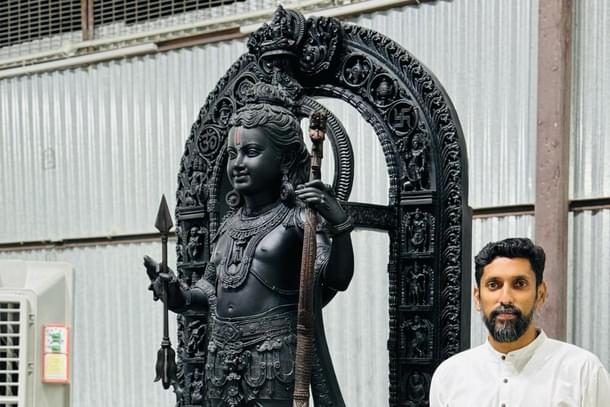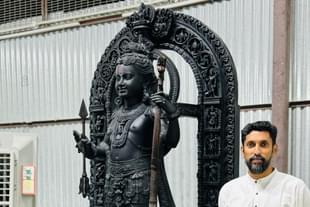Culture
The Best Arun Yogiraj Interview That Many Missed
Sharan Setty
Jan 28, 2024, 06:56 PM | Updated 06:56 PM IST
Save & read from anywhere!
Bookmark stories for easy access on any device or the Swarajya app.


Over the past few years, Mysuru-based sculptor Arun Yogiraj has attained celebrity status after creating some noteworthy murtis and statues.
His most popular work, by far, is the murti of Ramlalla — depicting Lord Ram as a five-year-old child in a standing posture holding a bow and arrow.
He was given a hero's welcome in Bengaluru when he got back home from Ayodhya after attending the prana pratishtha of the murti created by him.
Since then, he has been speaking to the media and giving interviews in English, Hindi, and Kannada.
Among these interviews, the one with senior journalist H R Ranganath on Public TV (a Kannada news channel), brings out the best in Yogiraj.
With his devotion and a deep understanding of his discipline, Arun delivers an in-depth interview which explains the struggle, hard work, and the sacrifices he had to make to realise everyone's dream.
Here are translated excerpts from the interview for those who could not watch it or understand Kannada —
HRR: Greetings, everyone, I am Ranganath. Over the last two weeks, everyone has been in a Rama Dhyana. We have been witness to a historic occasion.
A few people are unable to realise the importance of such an event, but after two or three centuries, when younger generations read about this in history books, we will understand its importance. Politics of the day aside, the importance of the janmabhoomi will not cease to exist.
Politics existed even during the time of Sri Ramachandra, but no one remembers it now. People remember Shri Ramachandra, not the politics of his time. Karnataka's blessed in a way — both shilpi (sculptor) and the stone are from our state. What more could we have wished for?
Through this interview, I am trying to fulfil my wish by talking to Arun Yogiraj. I rarely praise people on my shows. But I am elated today. I am taking your questions to him today.
Namaskara, Arun, thank you so much for joining us — on behalf of the people of Karnataka and India.
AY: Namaskara, thank you so much.
HRR: So many people convey their 'namaskara' to you, how do you feel?
AY: I think all these namaskaras should reach the feet of Lord Ram.
HRR: Why?
AY: Because we are merely an instrument of Lord Ram. He made us do everything we did. If anyone claims to have 'made' God, then there is no bigger fool than him. So all the namaskaras should reach Rama, elders in my family and our kuladeva.
Ranganath then asks him why he quit a corporate job after finishing his MBA. Arun says that he could not see his father struggle.
AY: Never in his entire life did my father ask me to help him out even once. Including when he suffered a heart attack once. My father told me that sculpting is very different from a corporate gig. You cannot outsource this work to anyone else. Unless you are ready to voluntarily work, then there's no point.
HRR: How were you selected to sculpt the murti?
AY: The process began in January (2023). There were other sculptors from Karnataka too. I was not invited. I was curious why. By then, I had just finished working on two important projects — Sri Adishankaracharya's murti at Kedarnath and Netaji Subhash Bose at India Gate in Delhi. I wondered why I was not invited. Anyway, I did not want to be greedy for more, and I kept quiet.
A sculptor was to be finalised. In IGNCA, Sachindra Joshi was the chairman. I knew him in Delhi. He asked his colleagues whether I was present. Realising that I was absent, he postponed the meeting. He called me to Delhi overnight. I flew there immediately. Some politics in the trust led me to my name being omitted. In April, I showed them my previous work and they were very happy.
People at the trust were also very happy. I got a letter stating I was selected. They asked me to bring someone with me to test out the stones. I told them I will personally do it, since I am the one who will be sculpting the murti.
There were seven or eight varieties of stones. From Nepal, Andhra Pradesh, Karnataka etc. I had a look at one stone (Krishna Shila), and I immediately knew it was from Mysuru. I can recognise a stone when I see it. I have spent my entire life around them. I selected it because I am more familiar with Krishna Shila. It is very lethal.
Krishna Shila does not react to water, fire, air or acid. Imagine this, our ancestors nearly a millennia ago knew of this. That's why we have been using the stone for so many centuries now. When we serve teertha after pouring milk on the vigraha, there is a small chance that the devotees may experience food poisoning after consuming it.
That's why our ancestors have been using this stone for garbagudis for the last 1,500 years.
HRR: Weren't you scared when you started?
AY: I think that is natural. More than being scared, I felt the need to do this for my people back home in Mysuru. Even a grandmother from the tiniest hamlet in my village should be able to do a darshan when this is done. Many devotees spend their life savings to visit temples. When they do that in Ayodhya, they must feel content. They must feel blessed. That was my objective.
HRR: Don't you want money for this?
AY: I still haven't asked for anything. I will accept whatever I am given. Even we have a life to lead. But God has been kind to us so far.
HRR: Shilpis provide us with murtis that we remember for generations. But they are not in pursuit of fame or money. Unlike painters, sculptors never etch their names on their art. So, do you never think about leaving a legacy behind?
AY: We have received our place in history, but I wanted to know the shilpi who sculpted Lord Venkateshwara's murti in Tirupati and other temples in the country.
HRR: Did the Prime Minister have a look at the murti beforehand?
AY: I have been told that the prime minister was happy with the murti I sculpted. Among the three, the murti that I sculpted was then selected, and I have been told that the PM, along with other trustees, may have had a say in it. It's hearsay, but that's what I heard.
HRR: Did you take feedback on how the murti looked?
AY: Just from my eight-year-old daughter Sanvi. I just asked her whether the murti looked like a boy or a man, and she replied that he looked like a boy. I was relieved. They say, if a child likes a movie, everyone else are bound to like it. Similarly, I thought the same in this case.
HRR: How was your seven months sculpting the idol?
AY: There were purohitas with us all throughout. Rituals had to be performed every day before we commenced work. We had a protein-heavy breakfast since we needed the energy to work. We worked for nearly 12 hours every day. I wish my father was alive to see this day.
We used to wear protective eye-wear every day. But on one occasion, when I kept it aside for ten minutes, I sustained an injury in my eye. But I was given immediate medical attention. I had to work with just one eye for a few days.
HRR: Why did you choose dashavathara?
AY: Vishnu sampradaya is being followed, hence dashavathara. Ram is a form of Vishnu, that is why. That is why Buddha, Kalki and Balarama were also present. The jewellery came from Lucknow. I was astonished to see the amount of gold that was used.
HRR: What next?
AY: I hope to improve my work and be more responsible with my projects in the future.
HRR: Fantastic. God bless you. I think they have already blessed you.
AY: It was like welcoming a baby to a palace. The temple is so huge. That was the feeling I had when we shifted the vigraha to the temple. I feel like I was living in a dreamland. I would wear a mask and ask people how the vigraha looked. Once I started getting satisfactory responses, I had a good night's sleep.
HRR: Your seven months' vanavasa has ended then?
AY: Yes, haha. Thank you, sir.
You can watch the full interview here.
Sharan Setty (Sharan K A) is an Associate Editor at Swarajya. He tweets at @sharansetty2.





